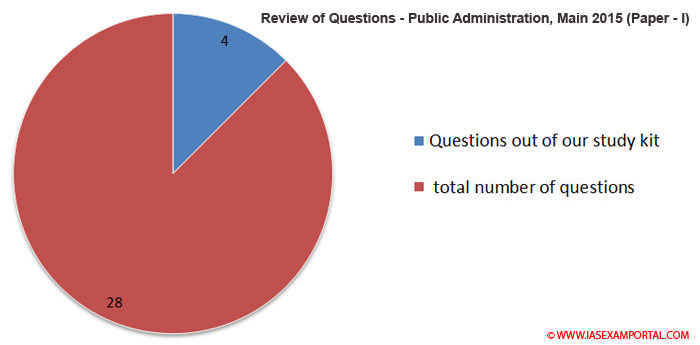Review of Questions - Public Administration, Main 2015 (Paper
- I)
UPSC comes with new word limits here: 10 marks = 150 words
So 15 marks = 225 words & 20 marks = 300 words.
Each Paper (I and II) with 250 marks and 3 hours’ time limit.
Eight Questions in two sections (A and B)
Question Paper Specific Instructions
- Please read each of the following instructions carefully before
attempting questions:
- There are EIGHT questions divided in two SECTIONS and printed both in
HINDI and in ENGLISH.
- Candidate has to attempt FIVE questions in all.
- Questions no. 1 and 5 are compulsory and out of the remaining, THREE are
to be attempted choosing at least ONE from each section.
- The number of marks carried by a question/part is indicated against it.
- Answer must be written in the medium authorized in the Admission
Certificate which must be stated clearly on the cover of this
Question-cum-Answer (QCA) Booklet in the space provided. No marks will be
given for answer written in a medium other than the authorized one.
- Word limit in questions, wherever specified, should be adhered to.
- Attempts of questions shall be counted in chronological order. Unless
struck off, attempt of a question shall be counted even if attempted partly.
Any page or portion of left blank in the answer book must be clearly struck
off.
Questions out of our study kit – 4
Total number of questions - 28

Section-A
Q1.Answer the following questions in about 150 words each: 10×5=50
A. Waldo’s The Administrative State’ provides a fundamental challenge to some
of the orthodox premises. Explain. (Introduction)
B. Discuss how the Public Choice Theory promotes the concept of ‘Steering’
and undermines the concept of ‘Rowing’ in visualising efficient and effective
administration. (Introduction- From our
Public Administration Study Kit - Page No-16 to 17)
C. “Delegated Legislation is a necessary evil.” Comment. ( Administrative
Law- From our
Public Administration Study Kit - Page No-108 to 110)
D. Do you agree with the view that the charismatic approach of the mid-1970s
is a “new version” of the Classical Trait Theory of Leadership? Give reasons.
(Administrative Behaviour- From our
Public Administration Study Kit - Page No-46 to 51)
E. “The term policy implementation is in some respects preferable to the
label public administration.” Argue. (Public Policy- From our
Public Administration Study Kit - Page No-182)
Q2. 20+15+15 marks
a. “Globalisation has transformed the nature and character of State from
traditional administrative Welfare State to a Corporate State.” Analyse the
changes in the nature of public administration in this context. (Introduction-
From our
Public Administration Study Kit - Page No- 17)
b. “Contemporary Organisational theory seems further afield of Chester
Barnard’s Functions of the Executive than of organisational ecology.” Examine
the statement in the light of ecological elements in Barnard’s thought.
(Administrative thought- From our
Public Administration Study Kit - Page No-37 to 38)
c. “PPPs serve too many parties and too many interests … to be focussed.”
Identify in the context of the statement, the parties involved in Public-Private
Partnerships and their conflicting aims. (Organisations- From our
Public Administration Study Kit - Page No- 73 to 76)
Q3. 20+ 15+ 15 marks
a. “Follett’s work was not directed towards the resolution of the conflict of
ideas, but towards the resolution of structural conflicts between workers and
capitalists.” In the light of the statement critically evaluate Follett’s idea
of dynamic administration. (Administrative thought- From our
Public Administration Study Kit - Page No-20 to 21)
b. “Information constitutes the life-blood of the functioning of an
organisation.” Explain the utility and significance of communication in
decision-making. (Administrative Behaviour- From our
Public Administration Study Kit - Page No- 43 to 45)
c. “Legislative action is not subject to the rules of natural justice.”
Explain the exceptions to the rule of natural justice. (Administrative Law- From
our
Public Administration Study Kit - Page No-78 to 80)